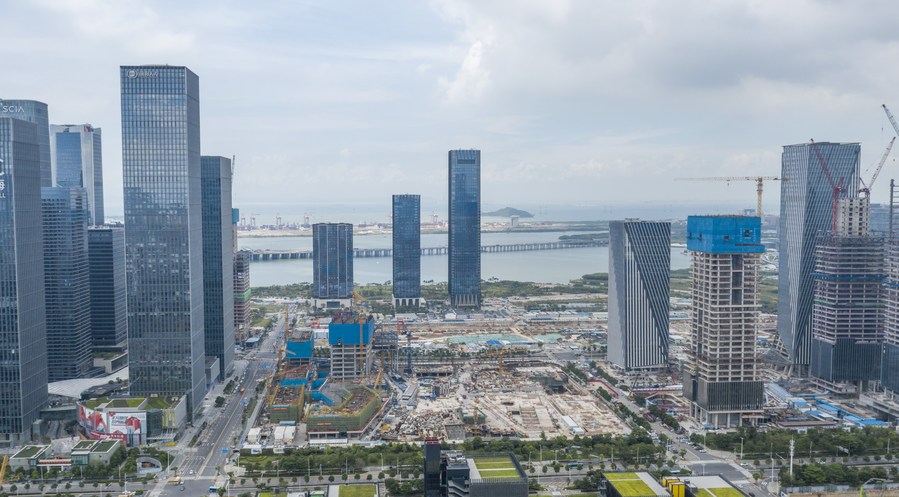
Aerial photo taken on Sept. 8, 2021 shows the construction site for a transaction center in Qianhai, Shenzhen City, south China's Guangdong Province. (Xinhua/Mao Siqian)
SHENZHEN, Dec. 21 (Xinhua) -- Xi Jinping, general secretary of the Communist Party of China (CPC) Central Committee, hailed reform and opening up as "a crucial move that made China what it is today" in the Qianhai area of the city of Shenzhen more than 10 years ago, highlighting the importance of the reform and opening up that has featured prominently since 1978.
Over the past decade, Shenzhen in south China has moved ahead with deepened reform and high-level opening up and become a global economic and technological powerhouse.
Embracing pilot and innovative projects, the city is striving to be a hub of innovation, entrepreneurship, and creativity.
XI'S VISITS
Xi has visited Shenzhen several times since assuming the post of general secretary of the CPC Central Committee in 2012.
In December that year, he chose Shenzhen as the first stop on his inspection tour. During the trip, Xi said reform and opening up was the source of vitality in the development of modern China, and "a magic tool" for the Party and the Chinese people to keep pace with the times.
While visiting Qianhai, Xi urged local officials to work meticulously to pioneer cooperation between Shenzhen and Hong Kong in the services sector and beyond.
Ten years ago, Qianhai consisted simply of large coastal swathes neighboring the Shenzhen airport. Covering over 120 square km, the area has now become a test-bed for institutional innovation under the framework of "one country, two systems."
Xi visited Shenzhen again in October 2018, when the country was celebrating the 40th anniversary of its reform and opening up. He urged the city to deepen cooperation with its neighbor Hong Kong to play a bigger role in building the Belt and Road, to advance the development of the Guangdong-Hong Kong-Macao Greater Bay Area, and to participate in international cooperation at higher levels.
In 2020, Xi attended a grand gathering to celebrate the 40th anniversary of the establishment of the Shenzhen Special Economic Zone, a key move behind its miraculous rise.
Shenzhen should deepen reform on all fronts, Xi said, noting that the CPC Central Committee supports the city in implementing pilot programs.
From 2012 to 2022, Shenzhen's GDP grew to 3.24 trillion yuan (about 455 billion U.S. dollars) from just over 1.29 trillion yuan. The city of more than 17 million people is now home to some of China's biggest tech players like Huawei, Tencent and BYD, which are among over 23,000 hi-tech enterprises based in Shenzhen.
LEAPFROG DEVELOPMENT
As a key area to implement reform and opening up policies planned by Xi, Qianhai has fashioned one reform scenario after another, said Wang Jinxia, deputy director of the Qianhai Authority.
Qianhai has taken the lead in reforming legal operations, the commercial registration system, and cross-border personnel employment, trade, investment and finance, said Wang.
The Qianhai Court has expanded the use of extraterritorial law in handling Hong Kong-related commercial cases to ensure that parties can use laws that "they are familiar with." Professionals from Hong Kong and Macao can be employed directly in Qianhai without having to be re-accredited. In order to supply the need for Hong Kong companies, Qianhai has offered a third of its land to Hong Kong firms and tax incentives to eligible firms.
"Qianhai has become an international commerce community. We have great confidence in the future," said Yu Tianlong, deputy general manager of Kerry Properties (Shenzhen) Co., Ltd.
Qianhai's GDP reached nearly 200 billion yuan and it recorded a total import and export value of 2.58 trillion yuan in 2022. A total of 645 institutional innovations have been launched in Qianhai, and among them 65 have been adopted and promoted nationwide, according to the authority.
Shenzhen is advancing an action plan to build a pilot zone for socialism with Chinese characteristics and is pressing ahead with its reforms.
Li Luyang, CEO of VisionNav Robotics, a company that develops driverless forklifts, attributed the firm's speedy growth to the resources and strength of Shenzhen. The firm's business revenue recorded a 10-fold expansion during the past three years.
"Seriously speaking, in Shenzhen I can build a prototype twice as fast as elsewhere," said Li, who came to the city after graduating from the Chinese University of Hong Kong.
"Talent, a complete industrial system, as well as an efficient and supportive government, have combined to make Shenzhen a perfect place for innovation," he said. ■




